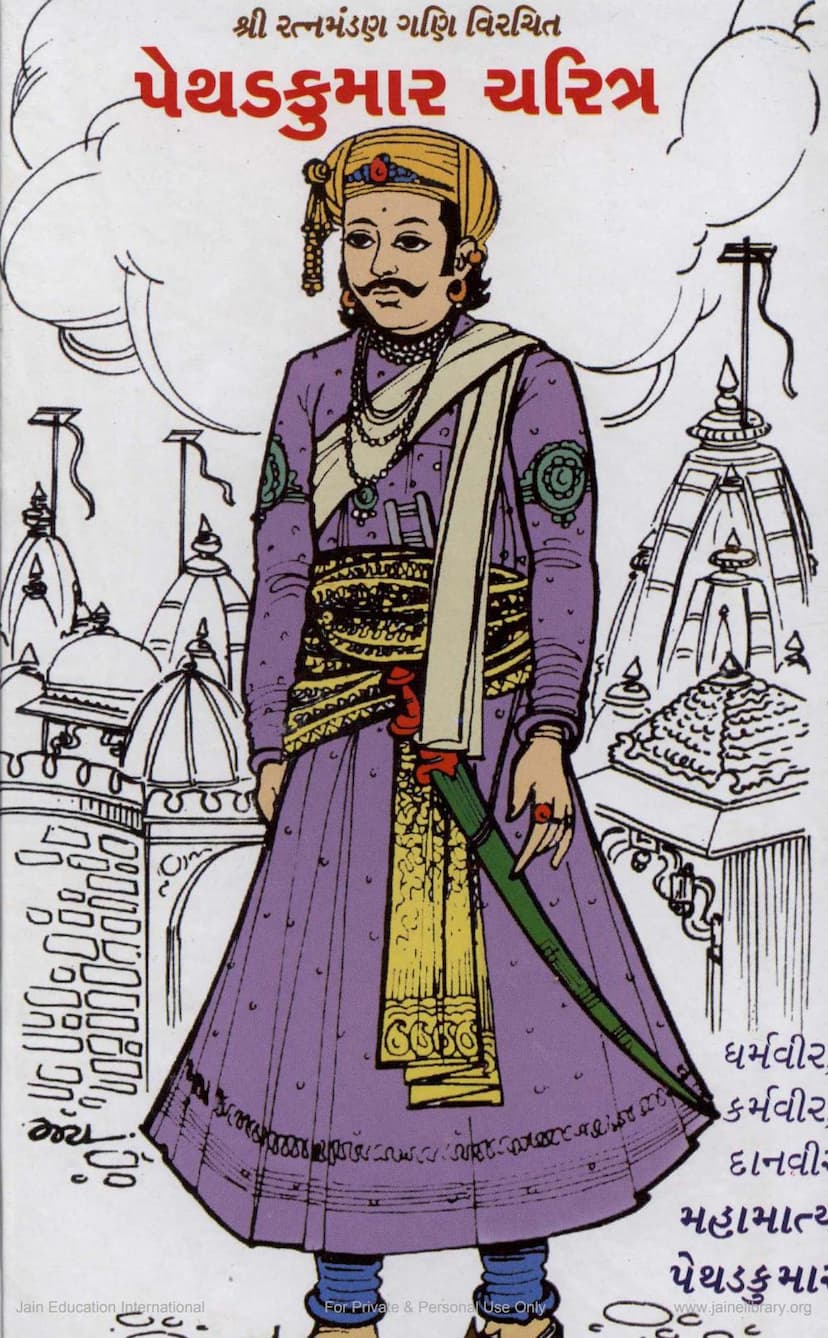Pethadkumar Charitra
Added to library: September 2, 2025

Summary
Here's a comprehensive summary of the Jain text "Pethadkumar Charitra" by Pradyumnasuri, based on the provided pages:
Title: Pethadkumar Charitra (The Biography of Pethadkumar) Author: Shri Ratnamandangaṇi (as mentioned in the translation and preface) Translator/Editor: Acharya Vijaypradyumnasuri Maharaj Saheb Publisher: Shri Shrutgyan Prasarak Sabha, Ahmedabad
Overall Purpose and Theme: The "Pethadkumar Charitra" is presented as a profound Jain biography, originally a Sanskrit poem called "Sukrutasaagar" (Ocean of Good Deeds). Its core purpose is to inspire readers by narrating the exemplary life and virtues of Pethadkumar, his father Dedashah, and his son Zanzaṇkumar. The text emphasizes the importance of righteous conduct, devotion to spiritual principles, generosity, self-control, and wise decision-making, particularly in the face of adversity. It aims to provide role models for Jains to navigate life's challenges and achieve spiritual progress.
Key Figures and their Significance:
- Pethadkumar (also referred to as Pethadshah): The central figure of the biography. He is portrayed as a righteous and virtuous individual who, despite facing extreme poverty and betrayal early in life, demonstrates immense inner strength, unwavering integrity, and profound devotion. His journey from destitution to becoming a highly respected minister and philanthropist is a major focus.
- Dedashah: Pethadkumar's father, who initially experienced extreme poverty due to debt. He undergoes a transformation through his encounter with a yogi, gaining the power of alchemical transmutation (turning base metals into gold). Despite his newfound wealth, he remains disciplined and ethical. His story highlights the importance of right action and seeking spiritual guidance.
- Zanzaṇkumar: Pethadkumar's virtuous son, who is depicted as brave, wise, and a skilled administrator. His actions often complement and extend the legacy of his father.
- Acharya Shri Dharmghoshsuriji: A pivotal spiritual guide who recognizes Pethad's potential and provides him with crucial advice and blessings, setting him on a path of righteousness and prosperity.
- Prathmini: Pethadkumar's devoted wife, who exemplifies virtue, loyalty, and unwavering faith, even during their period of extreme hardship.
Key Life Events and Teachings:
- Poverty and Transformation: Dedashah's initial struggle with debt and his encounter with a yogi who teaches him alchemy represent the beginning of the family's rise. This highlights the potential for transformation through divine grace and righteous association.
- Pethad's Early Life and Integrity: Despite his father's wealth, Pethad remains humble and principled. When his father attempts to bestow wealth, Pethad initially shows restraint, seeking guidance on how to manage it virtuously. His adherence to vows, even when tested, is emphasized.
- Pethad's Rise to Prominence: Through his wisdom, integrity, and virtuous actions, Pethad gains recognition and eventually becomes a minister in the court of King Jaisinghdev of Mandavgadh.
- Financial Discipline and Generosity: Pethad demonstrates remarkable financial acumen and a commitment to his vows, even when dealing with immense wealth. He uses his prosperity for charitable acts, building temples and supporting the Jain community.
- Pethad's Renunciation of Worldly Pleasures: A significant event is Pethad's acceptance of the vow of Brahmacharya (celibacy) under the guidance of Acharya Dharmghoshsuriji, inspired by a gift from a devout merchant named Bhim. This demonstrates a deep commitment to spiritual ideals over material comforts.
- The Devagiri Temple: A major achievement attributed to Pethad is the construction of a magnificent Jain temple in Devagiri (modern Daulatabad). This epic undertaking showcases his immense devotion and resources, intended to spread Jainism. The text details the architectural splendor and the substantial investment made.
- The Tale of Rani Lilavati: This episode highlights the influence of slander and the importance of divine intervention (through the recitation of the Navkar Mantra) to overcome false accusations and restore justice. Pethad's wife, Prathmini, plays a crucial role in supporting Rani Lilavati.
- Zanzaṇkumar's Virtues: Zanzaṇkumar is portrayed as a capable successor, demonstrating bravery, administrative skill, and devotion through his participation in pilgrimages and his role in public service.
- The Significance of Pilgrimages: The text details Pethad and Zanzaṇ's extensive travels to sacred Jain sites like Shatrunjay and Girnar, emphasizing the spiritual merit gained through such journeys.
- The Competition at Girnar: The narrative vividly describes a competition between the Jain community (led by Pethad) and the Digambara sect for the right to perform rituals at Girnar, with the winner determined by who could offer more gold for the "Indramala." Pethad's victory underscores his immense wealth and devotion.
- Philanthropy and Public Service: Throughout their lives, Pethad and Zanzaṇ engage in extensive charitable activities, including feeding the needy, constructing temples, and upholding Jain principles in their administrative duties.
- The "Sukrutasaagar" and its Purpose: The text itself, a Sanskrit poem, is lauded for its narrative power and ability to convey deep spiritual truths through engaging stories. The editor stresses the importance of reading such biographies to find inspiration and guidance for personal growth.
Structure and Style: The "Pethadkumar Charitra" is structured into eight "tarangas" (waves or chapters). It is written in a descriptive and often ornate style, filled with philosophical insights, moral maxims (shlokas), and detailed accounts of events, rituals, and architectural achievements. The narrative artfully weaves together the lives of three generations, illustrating the continuity of virtue and spiritual dedication.
Overall Message: The Pethadkumar Charitra serves as a testament to the Jain ideal of a householder's life, demonstrating how material prosperity can be attained and utilized for spiritual advancement and the propagation of Dharma. It highlights the power of faith, ethical conduct, the guidance of spiritual masters, and unwavering devotion in overcoming obstacles and achieving a meaningful life.